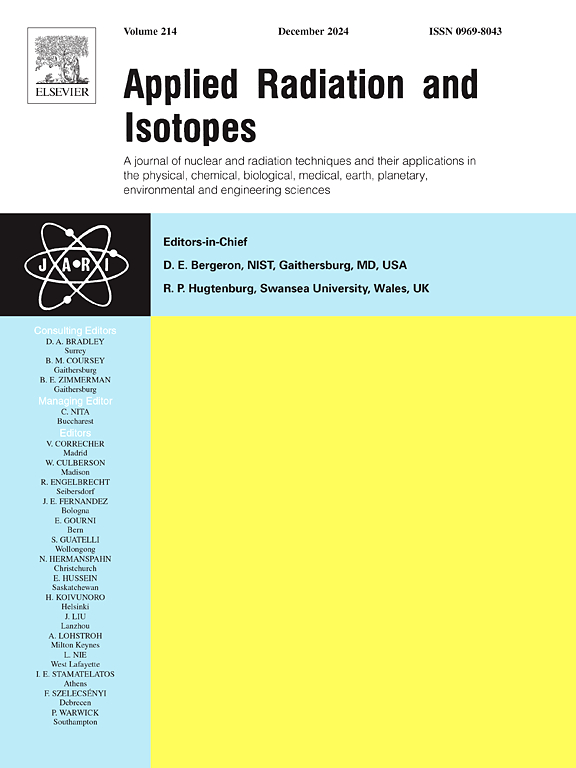An automatic patient-specific quality assurance with a novel DVH scoring algorithm for volumetric modulated arc therapy of cervical cancer
IF 1.8
3区 工程技术
Q3 CHEMISTRY, INORGANIC & NUCLEAR
引用次数: 0
Abstract
Purpose
To develop a novel DVH scoring algorithm to predict and classify patient-specific quality assurance (PSQA) results by different DVH metrics automatically and efficiently.
Methods
A total of 200 cervical cancer patients who treated by Infinity (109 cases) and Synergy (91 cases) linear accelerators underwent volumetric modulated arc therapy (VMAT) from 2019 to 2022 were enrolled and used as technical testing (TT) and technical validation (TV) datasets, respectively, which was then randomly divided into training, validation and testing set at a ratio of 7:1:2. PSQA dose distributions were predicted using U-shape-like network with skip-connection modules (called T-Net) with the input of CT and plan dose distributions. A novel weight-based DVH scoring (WDS) algorithm was developed and trained to classify “pass” or “fail” (PoF) of PSQA results based on the dose errors (DEs) and volumetric errors (VEs) calculated between predicted and planned DVHs.
Results
T-Net achieved a best performance in predicting PSQA dose distributions in comparison with other deep learning models. The WDS method achieved a sensitivity, specificity and accuracy of 100.00 %, 50.00 %, 0.955, and 100.00 %,33.33 %, 0.890 in TT and TV, respectively, which was better than models of random forest (RF) and support vector machines (SVM) with an accuracy of 0.909, 0.833 and 0.864, 0.722 in TT and TV, respectively. The threshold DVH score for 22 and 18 validation patients were 49.62 and 57.62 in the TT and TV with a precision, recall rate and F1 score of 0.952, 1, 0.976 and 0.882, 1, 0.938, respectively.
Conclusions
The suggested novel WDS algorithm can improve the accuracy and efficiency of classifying the PoF of PSQA objectively and automatically.
用于子宫颈癌体积调制弧线治疗的新型DVH评分算法的自动患者特异性质量保证
目的开发一种新的DVH评分算法,对不同DVH指标的患者特异性质量保证(PSQA)结果进行自动、高效的预测和分类。方法选取2019 - 2022年使用Infinity线性加速器(109例)和Synergy线性加速器(91例)进行体积调制电弧治疗(VMAT)的宫颈癌患者200例,分别作为技术测试(TT)和技术验证(TV)数据集,按7:1:2的比例随机分为训练集、验证集和测试集。以CT输入和计划剂量分布为输入,使用带有跳过连接模块(称为T-Net)的u形网络预测PSQA剂量分布。开发并训练了一种新的基于权重的DVH评分(WDS)算法,根据预测DVH和计划DVH之间计算的剂量误差(DEs)和体积误差(VEs)对PSQA结果进行“合格”或“不合格”(PoF)分类。结果与其他深度学习模型相比,tst - net在预测PSQA剂量分布方面取得了最好的效果。WDS方法在TT和TV上的灵敏度、特异度和准确度分别为100.00%、50.00%、0.955和100.00%、33.33%、0.890,优于随机森林(RF)模型和支持向量机(SVM)模型,前者在TT和TV上的准确度分别为0.909、0.833和0.864、0.722。22例和18例验证患者的TT和TV阈值分别为49.62和57.62,准确率、召回率和F1评分分别为0.952、1、0.976和0.882、1、0.938。结论本文提出的WDS算法能够客观、自动地提高pqa的PoF分类的准确性和效率。
本文章由计算机程序翻译,如有差异,请以英文原文为准。
求助全文
约1分钟内获得全文
求助全文
来源期刊

Applied Radiation and Isotopes
工程技术-核科学技术
CiteScore
3.00
自引率
12.50%
发文量
406
审稿时长
13.5 months
期刊介绍:
Applied Radiation and Isotopes provides a high quality medium for the publication of substantial, original and scientific and technological papers on the development and peaceful application of nuclear, radiation and radionuclide techniques in chemistry, physics, biochemistry, biology, medicine, security, engineering and in the earth, planetary and environmental sciences, all including dosimetry. Nuclear techniques are defined in the broadest sense and both experimental and theoretical papers are welcome. They include the development and use of α- and β-particles, X-rays and γ-rays, neutrons and other nuclear particles and radiations from all sources, including radionuclides, synchrotron sources, cyclotrons and reactors and from the natural environment.
The journal aims to publish papers with significance to an international audience, containing substantial novelty and scientific impact. The Editors reserve the rights to reject, with or without external review, papers that do not meet these criteria.
Papers dealing with radiation processing, i.e., where radiation is used to bring about a biological, chemical or physical change in a material, should be directed to our sister journal Radiation Physics and Chemistry.
 求助内容:
求助内容: 应助结果提醒方式:
应助结果提醒方式:


